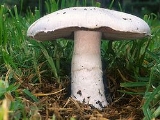
Agaricus
Overview
Genus
In biology, a genus is a low-level taxonomic rank used in the biological classification of living and fossil organisms, which is an example of definition by genus and differentia...
of mushroom
Mushroom
A mushroom is the fleshy, spore-bearing fruiting body of a fungus, typically produced above ground on soil or on its food source. The standard for the name "mushroom" is the cultivated white button mushroom, Agaricus bisporus; hence the word "mushroom" is most often applied to those fungi that...
s containing both edible
Edible mushroom
Edible mushrooms are the fleshy and edible fruiting bodies of several species of fungi. Mushrooms belong to the macrofungi, because their fruiting structures are large enough to be seen with the naked eye. They can appear either below ground or above ground where they may be picked by hand...
and poisonous species, with possibly over 300 members worldwide. The genus includes the common ("button") mushroom (Agaricus bisporus) and the field mushroom (Agaricus campestris
Agaricus campestris
Agaricus campestris is commonly known as the field mushroom or, in North America, meadow mushroom. It is a widely eaten gilled mushroom closely related to the cultivated button mushroom Agaricus bisporus.-Taxonomy:...
), the dominant cultivated mushrooms of the West.
Members of Agaricus are characterized by having a fleshy cap or pileus
Pileus (mycology)
The pileus is the technical name for the cap, or cap-like part, of a basidiocarp or ascocarp that supports a spore-bearing surface, the hymenium. The hymenium may consist of lamellae, tubes, or teeth, on the underside of the pileus...
, from the underside of which grow a number of radiating plates or gill
Gill (mushroom)
A lamella, or gill, is a papery hymenophore rib under the cap of some mushroom species, most often but not always agarics. The gills are used by the mushrooms as a means of spore dispersal, and are important for species identification...
s on which are produced the naked spore
Spore
In biology, a spore is a reproductive structure that is adapted for dispersal and surviving for extended periods of time in unfavorable conditions. Spores form part of the life cycles of many bacteria, plants, algae, fungi and some protozoa. According to scientist Dr...
s.
Unanswered Questions

